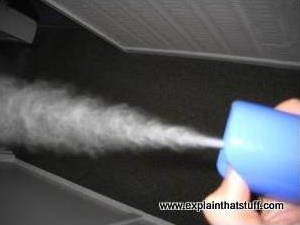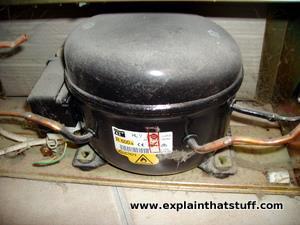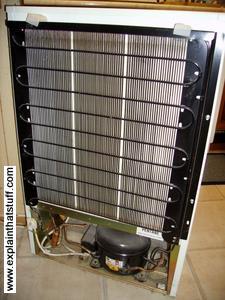
Refrigerators
by Chris Woodford. Last updated: January 2, 2022.
Now here's a cool idea: a metal box that helps your food last longer! Have you ever stopped to think how a refrigerator keeps cool, calm, and collected even in the blistering heat of summer? Food goes bad because bacteria breed inside it. But bacteria grow less quickly at lower temperatures, so the cooler you can keep food, the longer it will last. A refrigerator is a machine that keeps food cool with some very clever science. All the time your refrigerator is humming away, liquids are turning into gases, water is turning into ice, and your food is staying deliciously fresh. Let's take a closer look at how a refrigerator works!
Photo: A typical domestic refrigerator or "fridge" keeps food at a temperature roughly 0–5°C (32–41°F). Freezers work in a similar way, but cool down to a much lower temperature, typically −18 to −23°C (0 to −10°F). This model has an icebox (the light yellow box at the top) that acts as a mini freezer, which should be at freezer temperatures rather than fridge ones.
Sponsored links
Contents
How to move something you can't even see
Suppose your chore for today is to empty a stable full of rank smelling horse manure. Not the nicest of jobs, so you'll want to do it as quickly as possible. You won't be able to move it all at once, because there's too much of it. To get the job done fast, you need to move as much manure as you can in one go. The best thing to do is use a wheelbarrow. Pile the manure up into the barrow, wheel the barrow outside, and then empty the manure into a pile in the stable yard. With a few of these trips, you can shift the manure from inside the stable to outside.
Moving something you can see is easy. But now let's give you a harder chore. Your new task is to move the heat from the inside of a refrigerator to the outside to keep your food fresh. How can you move something you can't see? You can't use a wheelbarrow this time. Not only that, but you can't open the door to get at the heat inside, or you'll let the heat straight back in again. Your mission is to remove the heat, continually, without opening the door even once. Tricky problem, eh? But it's not impossible—at least not if you understand the science of liquids and gases.
How to move heat with a gas
Let's step sideways a moment and look at how gases behave. If you've ever pumped up the tires on a bicycle, you'll know that a bicycle pump soon gets quite warm. The reason is that gases heat up when you compress (squeeze) them. To make the tire support the weight of the bicycle and your body, you have to squeeze air into it at a high pressure. Pumping makes the air (and the pump it passes through) a little bit hotter. Why? As you squeeze the air, you have to work quite hard with the pump. The energy you use in pumping is converted into potential energy in the compressed gas: the gas in the tire is at a higher pressure and higher temperature than the cool air around you. If you squeeze a gas into half the volume, the heat energy its molecules contain fills only half as much space, so the temperature of the gas rises (it gets hotter).

Artwork: Gases get hotter when you compress them into less volume, because you have to work to push their energetic molecules closer together. For example, when you inflate a bicycle tire, the pump sucks in air and squeezes it into less space. This forces its molecules (red blobs) together and makes it heat up.
Moving more heat by changing gases into liquids and back
If you have an inventive sort of mind, you can probably imagine cobbling together some sort of pump-like contraption that inflates a bike tire in one place and then deflates it another place, which would move heat between the two. It's a clumsy idea though, and we can't really move much heat like that: we'd need an awful lot of gas, for one thing. We could, however, move a decent amount of heat by letting a gas expand and contract much more so it converts into a liquid and back again—in other words by changing it into a different state of matter.
How would that work? Look what happens with an aerosol can, which contains a liquid stored under pressure. When you spray an aerosol onto your hand, you've probably noticed that it feels really cold. That's partly because some of the liquid cools and vaporizes (turns to a gas) as it leaves the can. But it's also because some of the liquid hits your warm skin and vaporizes at that point: it turns into a gas by stealing heat from your body—and that makes your skin feel cooler. This tells us that allowing liquids to expand and turn into gases is a very effective way to remove heat from things. That's no big surprise: it's how sweating works—and why dogs stick their tongues out to cool down on hot days.

Photo: Liquids can turn to gases (and gases cool down) when you let them expand into more volume. That's why aerosol sprays feel so cold.
Although solids and liquids take up broadly the same amount of space, gases take up very much more room than either. The molecules in a solid or liquid are quite close together and attract one another with a great deal of force. When a liquid turns into a gas, or vaporizes, some of its more energetic molecules pull apart and break away. It takes a lot of energy to make this happen, which is known as the latent heat of vaporization, and that energy has to come from within the liquid itself or something nearby. In other words, changing a liquid into a gas is a way to remove the energy from something, while changing a gas back into a liquid is a way to release that energy again. This is essentially how refrigerators move heat from their cooling cabinet to the room outside. They turn a liquid into a gas inside the cooling cabinet (to pick up heat from the stored food), pump it outside the cabinet, and change it back into a liquid again (to release the heat on the outside).

Animation: The basic idea of what's sometimes called mechanical refrigeration. Inside a refrigerator (1), we change a liquid into a gas to pick up heat from inside the cooling cabinet (2), pump it outside the machine, and then change it back into a liquid to release its heat there (3).
The heating and cooling cycle
By compressing gases into liquids, we can release heat; by letting liquids expand into gases, we can soak up heat. How can we use this handy bit of physics to shift heat from the inside of a refrigerator to the outside? Suppose we made a pipe that was partly inside a refrigerator and partly outside it, and sealed so it was a continuous loop. And suppose we filled the pipe with a carefully chosen chemical (one with a low boiling point) that easily changed back and forth between liquid and gas, which is known as the coolant or refrigerant. Inside the refrigerator, we could make the pipe suddenly get wider, so the liquid coolant would expand into a gas and cool the chiller cabinet as it flowed through it. Outside the refrigerator, we could have something like a bicycle pump to compress the gas, release its heat, and turn it back into a liquid. If the chemical flowed round and round the loop, expanding when it was inside the refrigerator and compressing when it was outside, it would constantly pick up heat from the inside and carry it to the outside like a heat conveyor belt. In this way, we could constantly move heat from a cold place (inside the refrigerator) to a hotter one (outside it), which is not something that the laws of physics allow to happen automatically (left to its own devices, heat flows from hotter things to colder ones).
And, surprise surprise, this is almost exactly how a refrigerator works. There are some extra details worth noting. Inside the refrigerator, the pipe expands through a nozzle known as an expansion valve (more technically, it's what's called a fixed orifice). As the liquid coolant passes through it, it cools dramatically and turns partly into a gas. This bit of science is sometimes known as the Joule-Thomson (or Joule-Kelvin) effect for the physicists who discovered it, James Prescott Joule (1818–1889) and William Thomson (Lord Kelvin, 1824–1907). You won't be surprised to discover that the compressor outside the refrigerator is not really a bicycle pump! It's actually an electrically powered pump. It's the thing that makes a refrigerator hum every so often. The compressor is attached to a grill-like device called a condenser (a kind of thin radiator behind the refrigerator) that expels the unwanted heat.


Photo: Humid air inside your fridge contains water vapor. When the refrigerator cools, this water turns to ice. The coldest part of your fridge is the icebox at the top. That's because the expansion valve is placed right next to it.
Photo: Here's the compressor from a typical refrigerator. Note the pipes carrying the coolant in one side and out the other. You can't see this unit unless you pull your appliance away from the wall, because it's tucked away around the back and at the bottom. See more photos of it in the box below.





